Mont Rose College: Business and Business Environment Report Analysis
VerifiedAdded on 2022/11/18
|9
|2341
|53
Report
AI Summary
This report delves into the intricacies of the business environment by examining three distinct organizational structures: public, private, and voluntary organizations. It begins by defining and differentiating these structures, highlighting their key characteristics, objectives, and operational frameworks. The report then provides real-world examples, such as KPMG (private), Royal Dutch Shell (public), and the Red Cross (voluntary), to illustrate how these organizational structures function in practice. Furthermore, it analyzes the relationship between an organization's structure and its objectives, demonstrating how each type is best suited to achieve specific goals. The report concludes by summarizing the main points and reinforcing the importance of understanding these organizational structures for effective business operations and societal contributions.
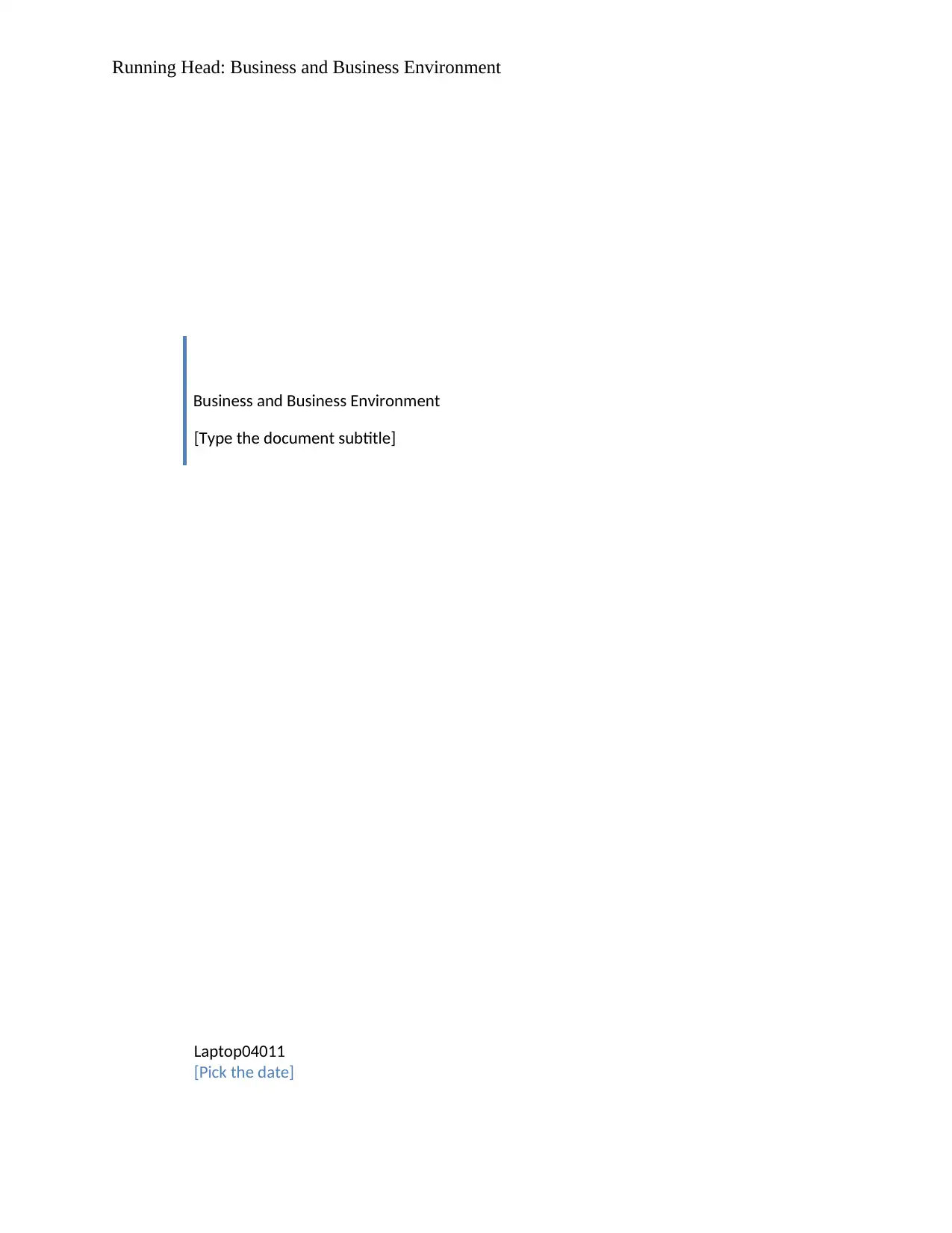
Running Head: Business and Business Environment
Business and Business Environment
[Type the document subtitle]
Laptop04011
[Pick the date]
Business and Business Environment
[Type the document subtitle]
Laptop04011
[Pick the date]
Paraphrase This Document
Need a fresh take? Get an instant paraphrase of this document with our AI Paraphraser
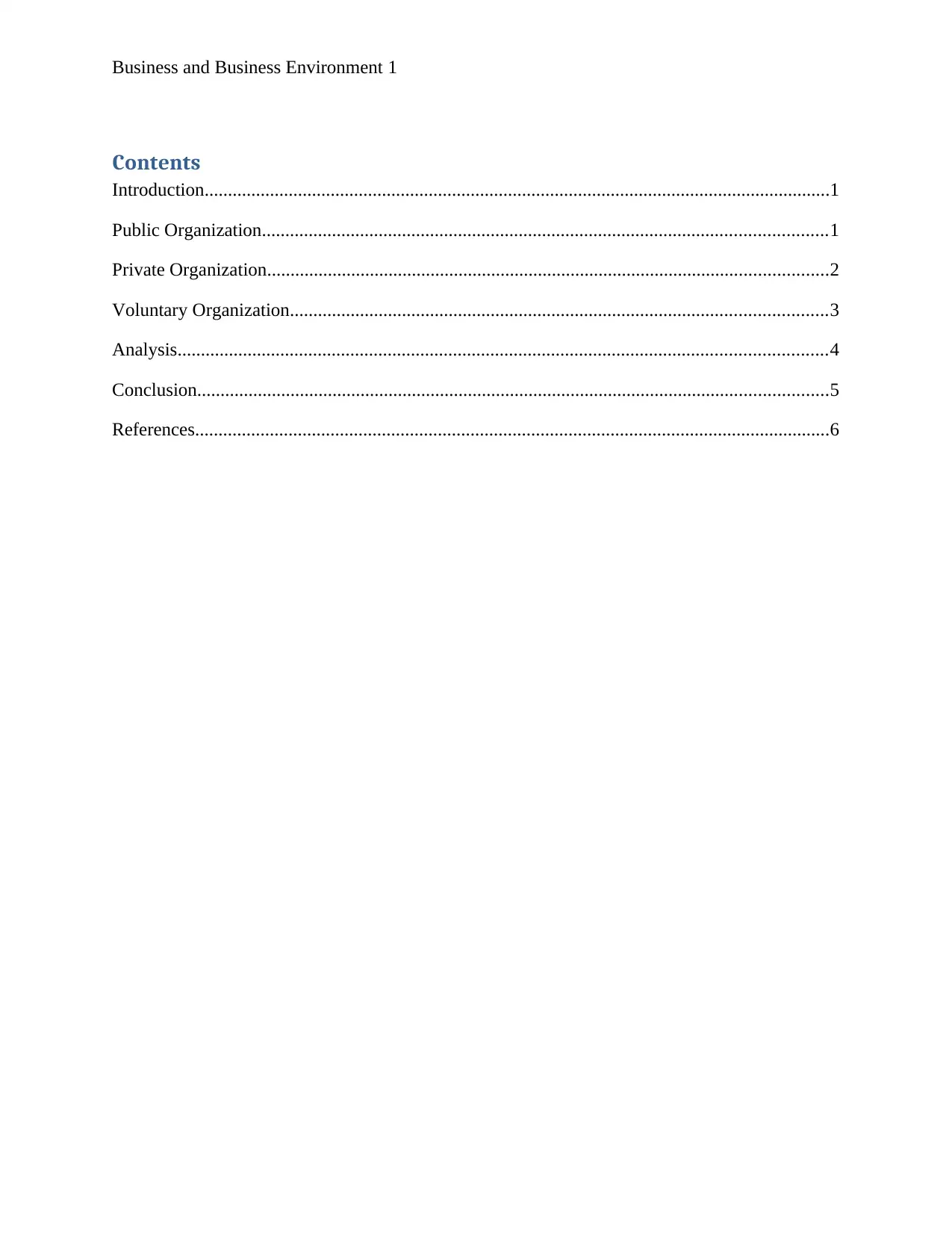
Business and Business Environment 1
Contents
Introduction......................................................................................................................................1
Public Organization.........................................................................................................................1
Private Organization........................................................................................................................2
Voluntary Organization...................................................................................................................3
Analysis...........................................................................................................................................4
Conclusion.......................................................................................................................................5
References........................................................................................................................................6
Contents
Introduction......................................................................................................................................1
Public Organization.........................................................................................................................1
Private Organization........................................................................................................................2
Voluntary Organization...................................................................................................................3
Analysis...........................................................................................................................................4
Conclusion.......................................................................................................................................5
References........................................................................................................................................6
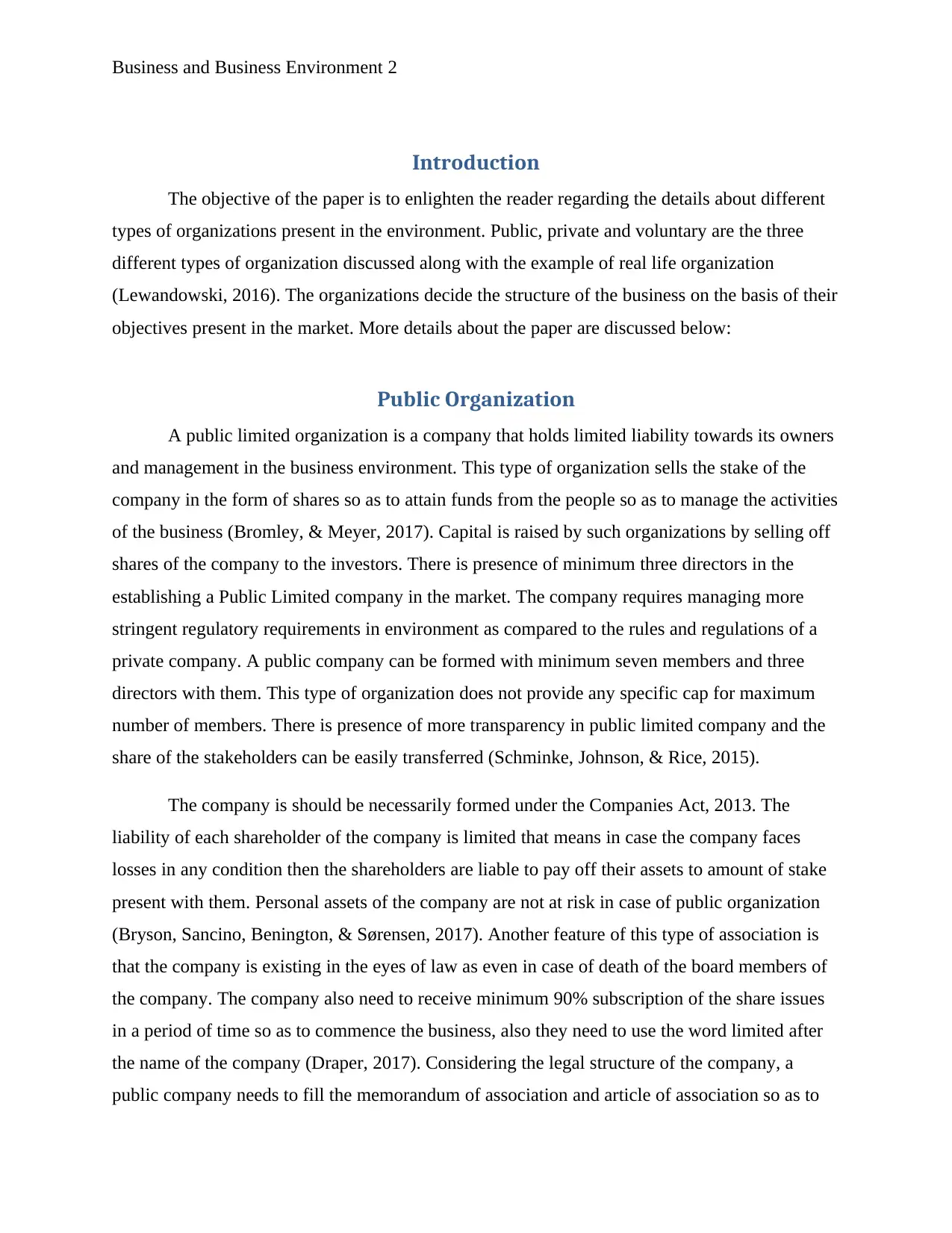
Business and Business Environment 2
Introduction
The objective of the paper is to enlighten the reader regarding the details about different
types of organizations present in the environment. Public, private and voluntary are the three
different types of organization discussed along with the example of real life organization
(Lewandowski, 2016). The organizations decide the structure of the business on the basis of their
objectives present in the market. More details about the paper are discussed below:
Public Organization
A public limited organization is a company that holds limited liability towards its owners
and management in the business environment. This type of organization sells the stake of the
company in the form of shares so as to attain funds from the people so as to manage the activities
of the business (Bromley, & Meyer, 2017). Capital is raised by such organizations by selling off
shares of the company to the investors. There is presence of minimum three directors in the
establishing a Public Limited company in the market. The company requires managing more
stringent regulatory requirements in environment as compared to the rules and regulations of a
private company. A public company can be formed with minimum seven members and three
directors with them. This type of organization does not provide any specific cap for maximum
number of members. There is presence of more transparency in public limited company and the
share of the stakeholders can be easily transferred (Schminke, Johnson, & Rice, 2015).
The company is should be necessarily formed under the Companies Act, 2013. The
liability of each shareholder of the company is limited that means in case the company faces
losses in any condition then the shareholders are liable to pay off their assets to amount of stake
present with them. Personal assets of the company are not at risk in case of public organization
(Bryson, Sancino, Benington, & Sørensen, 2017). Another feature of this type of association is
that the company is existing in the eyes of law as even in case of death of the board members of
the company. The company also need to receive minimum 90% subscription of the share issues
in a period of time so as to commence the business, also they need to use the word limited after
the name of the company (Draper, 2017). Considering the legal structure of the company, a
public company needs to fill the memorandum of association and article of association so as to
Introduction
The objective of the paper is to enlighten the reader regarding the details about different
types of organizations present in the environment. Public, private and voluntary are the three
different types of organization discussed along with the example of real life organization
(Lewandowski, 2016). The organizations decide the structure of the business on the basis of their
objectives present in the market. More details about the paper are discussed below:
Public Organization
A public limited organization is a company that holds limited liability towards its owners
and management in the business environment. This type of organization sells the stake of the
company in the form of shares so as to attain funds from the people so as to manage the activities
of the business (Bromley, & Meyer, 2017). Capital is raised by such organizations by selling off
shares of the company to the investors. There is presence of minimum three directors in the
establishing a Public Limited company in the market. The company requires managing more
stringent regulatory requirements in environment as compared to the rules and regulations of a
private company. A public company can be formed with minimum seven members and three
directors with them. This type of organization does not provide any specific cap for maximum
number of members. There is presence of more transparency in public limited company and the
share of the stakeholders can be easily transferred (Schminke, Johnson, & Rice, 2015).
The company is should be necessarily formed under the Companies Act, 2013. The
liability of each shareholder of the company is limited that means in case the company faces
losses in any condition then the shareholders are liable to pay off their assets to amount of stake
present with them. Personal assets of the company are not at risk in case of public organization
(Bryson, Sancino, Benington, & Sørensen, 2017). Another feature of this type of association is
that the company is existing in the eyes of law as even in case of death of the board members of
the company. The company also need to receive minimum 90% subscription of the share issues
in a period of time so as to commence the business, also they need to use the word limited after
the name of the company (Draper, 2017). Considering the legal structure of the company, a
public company needs to fill the memorandum of association and article of association so as to
⊘ This is a preview!⊘
Do you want full access?
Subscribe today to unlock all pages.

Trusted by 1+ million students worldwide
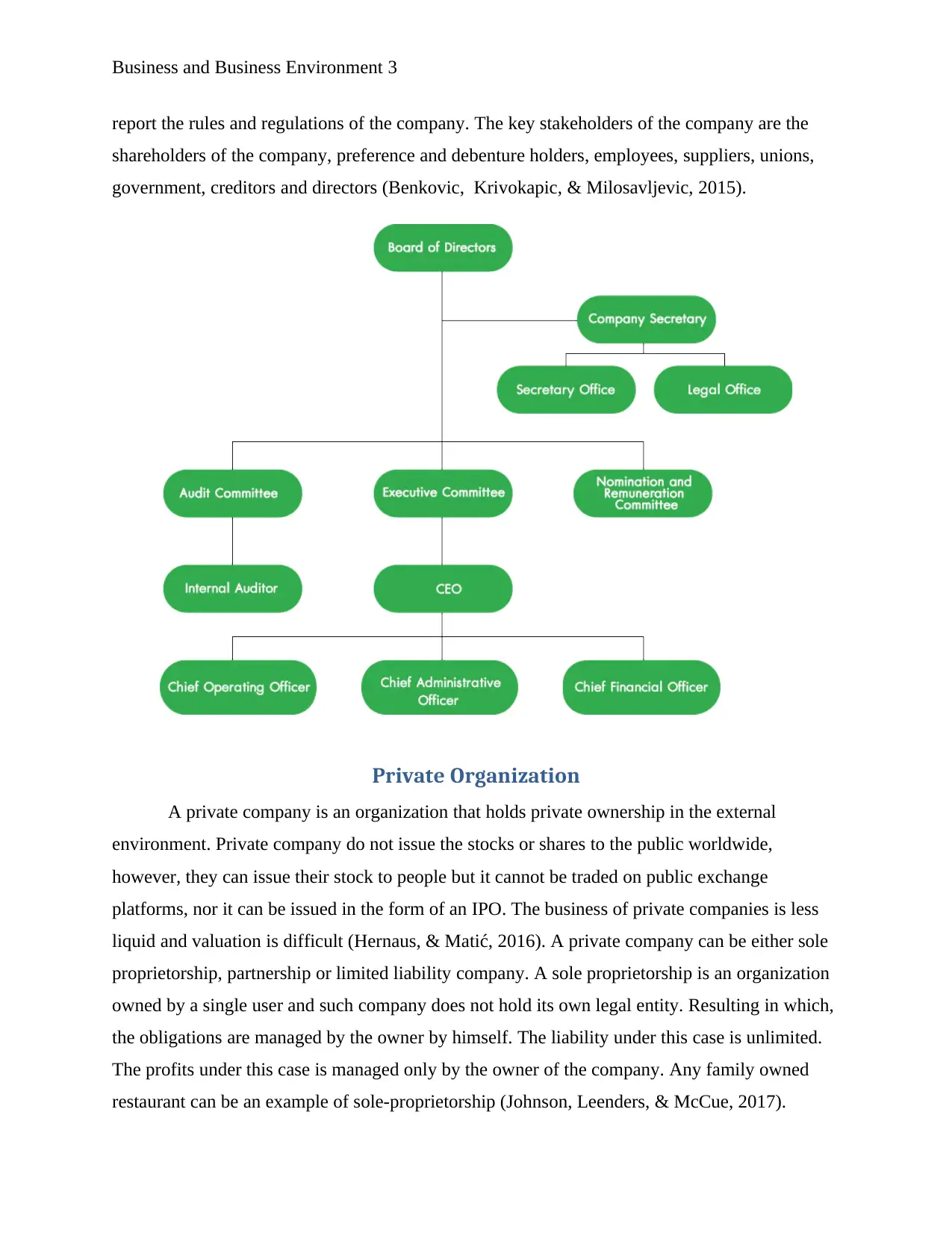
Business and Business Environment 3
report the rules and regulations of the company. The key stakeholders of the company are the
shareholders of the company, preference and debenture holders, employees, suppliers, unions,
government, creditors and directors (Benkovic, Krivokapic, & Milosavljevic, 2015).
Private Organization
A private company is an organization that holds private ownership in the external
environment. Private company do not issue the stocks or shares to the public worldwide,
however, they can issue their stock to people but it cannot be traded on public exchange
platforms, nor it can be issued in the form of an IPO. The business of private companies is less
liquid and valuation is difficult (Hernaus, & Matić, 2016). A private company can be either sole
proprietorship, partnership or limited liability company. A sole proprietorship is an organization
owned by a single user and such company does not hold its own legal entity. Resulting in which,
the obligations are managed by the owner by himself. The liability under this case is unlimited.
The profits under this case is managed only by the owner of the company. Any family owned
restaurant can be an example of sole-proprietorship (Johnson, Leenders, & McCue, 2017).
report the rules and regulations of the company. The key stakeholders of the company are the
shareholders of the company, preference and debenture holders, employees, suppliers, unions,
government, creditors and directors (Benkovic, Krivokapic, & Milosavljevic, 2015).
Private Organization
A private company is an organization that holds private ownership in the external
environment. Private company do not issue the stocks or shares to the public worldwide,
however, they can issue their stock to people but it cannot be traded on public exchange
platforms, nor it can be issued in the form of an IPO. The business of private companies is less
liquid and valuation is difficult (Hernaus, & Matić, 2016). A private company can be either sole
proprietorship, partnership or limited liability company. A sole proprietorship is an organization
owned by a single user and such company does not hold its own legal entity. Resulting in which,
the obligations are managed by the owner by himself. The liability under this case is unlimited.
The profits under this case is managed only by the owner of the company. Any family owned
restaurant can be an example of sole-proprietorship (Johnson, Leenders, & McCue, 2017).
Paraphrase This Document
Need a fresh take? Get an instant paraphrase of this document with our AI Paraphraser
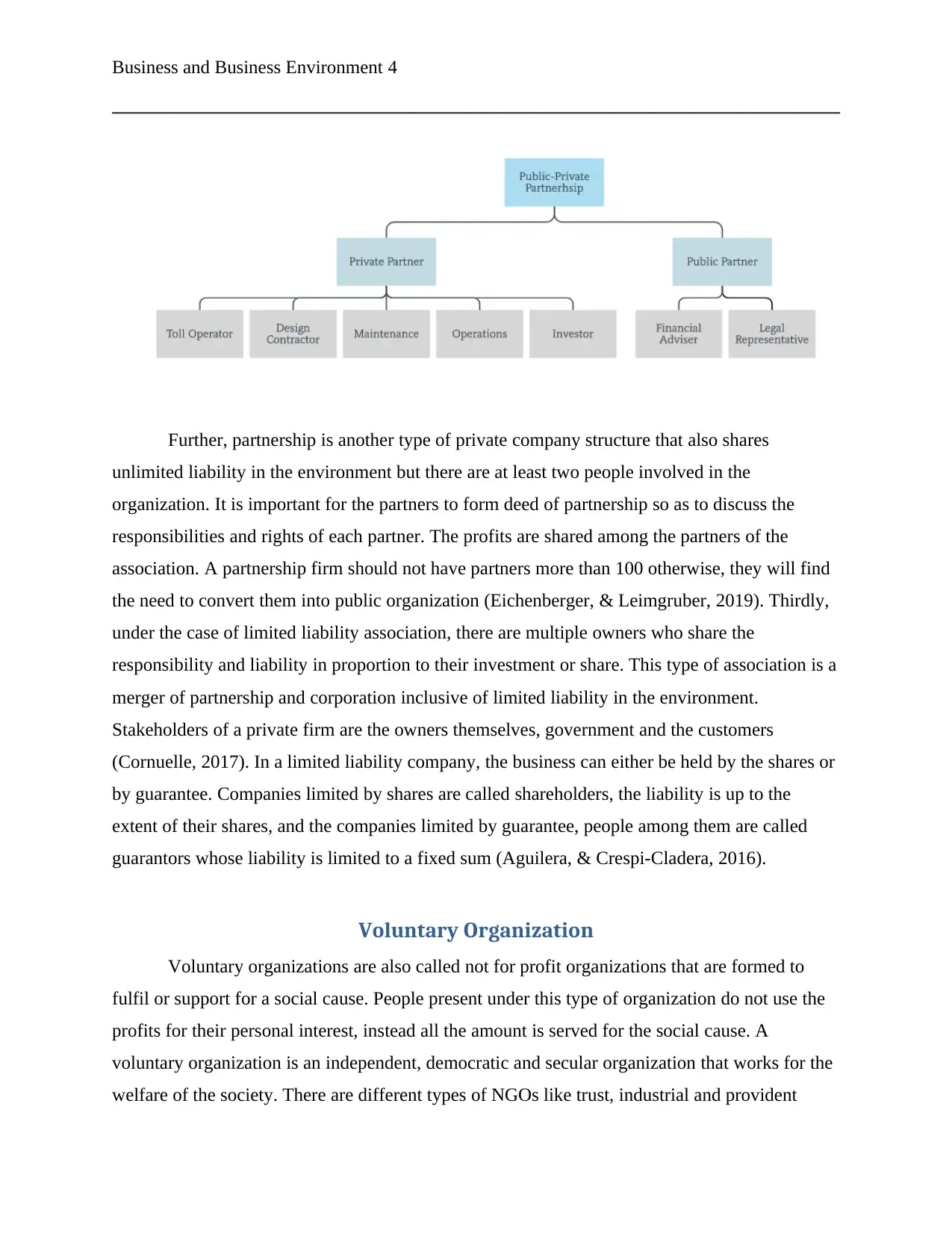
Business and Business Environment 4
Further, partnership is another type of private company structure that also shares
unlimited liability in the environment but there are at least two people involved in the
organization. It is important for the partners to form deed of partnership so as to discuss the
responsibilities and rights of each partner. The profits are shared among the partners of the
association. A partnership firm should not have partners more than 100 otherwise, they will find
the need to convert them into public organization (Eichenberger, & Leimgruber, 2019). Thirdly,
under the case of limited liability association, there are multiple owners who share the
responsibility and liability in proportion to their investment or share. This type of association is a
merger of partnership and corporation inclusive of limited liability in the environment.
Stakeholders of a private firm are the owners themselves, government and the customers
(Cornuelle, 2017). In a limited liability company, the business can either be held by the shares or
by guarantee. Companies limited by shares are called shareholders, the liability is up to the
extent of their shares, and the companies limited by guarantee, people among them are called
guarantors whose liability is limited to a fixed sum (Aguilera, & Crespi-Cladera, 2016).
Voluntary Organization
Voluntary organizations are also called not for profit organizations that are formed to
fulfil or support for a social cause. People present under this type of organization do not use the
profits for their personal interest, instead all the amount is served for the social cause. A
voluntary organization is an independent, democratic and secular organization that works for the
welfare of the society. There are different types of NGOs like trust, industrial and provident
Further, partnership is another type of private company structure that also shares
unlimited liability in the environment but there are at least two people involved in the
organization. It is important for the partners to form deed of partnership so as to discuss the
responsibilities and rights of each partner. The profits are shared among the partners of the
association. A partnership firm should not have partners more than 100 otherwise, they will find
the need to convert them into public organization (Eichenberger, & Leimgruber, 2019). Thirdly,
under the case of limited liability association, there are multiple owners who share the
responsibility and liability in proportion to their investment or share. This type of association is a
merger of partnership and corporation inclusive of limited liability in the environment.
Stakeholders of a private firm are the owners themselves, government and the customers
(Cornuelle, 2017). In a limited liability company, the business can either be held by the shares or
by guarantee. Companies limited by shares are called shareholders, the liability is up to the
extent of their shares, and the companies limited by guarantee, people among them are called
guarantors whose liability is limited to a fixed sum (Aguilera, & Crespi-Cladera, 2016).
Voluntary Organization
Voluntary organizations are also called not for profit organizations that are formed to
fulfil or support for a social cause. People present under this type of organization do not use the
profits for their personal interest, instead all the amount is served for the social cause. A
voluntary organization is an independent, democratic and secular organization that works for the
welfare of the society. There are different types of NGOs like trust, industrial and provident
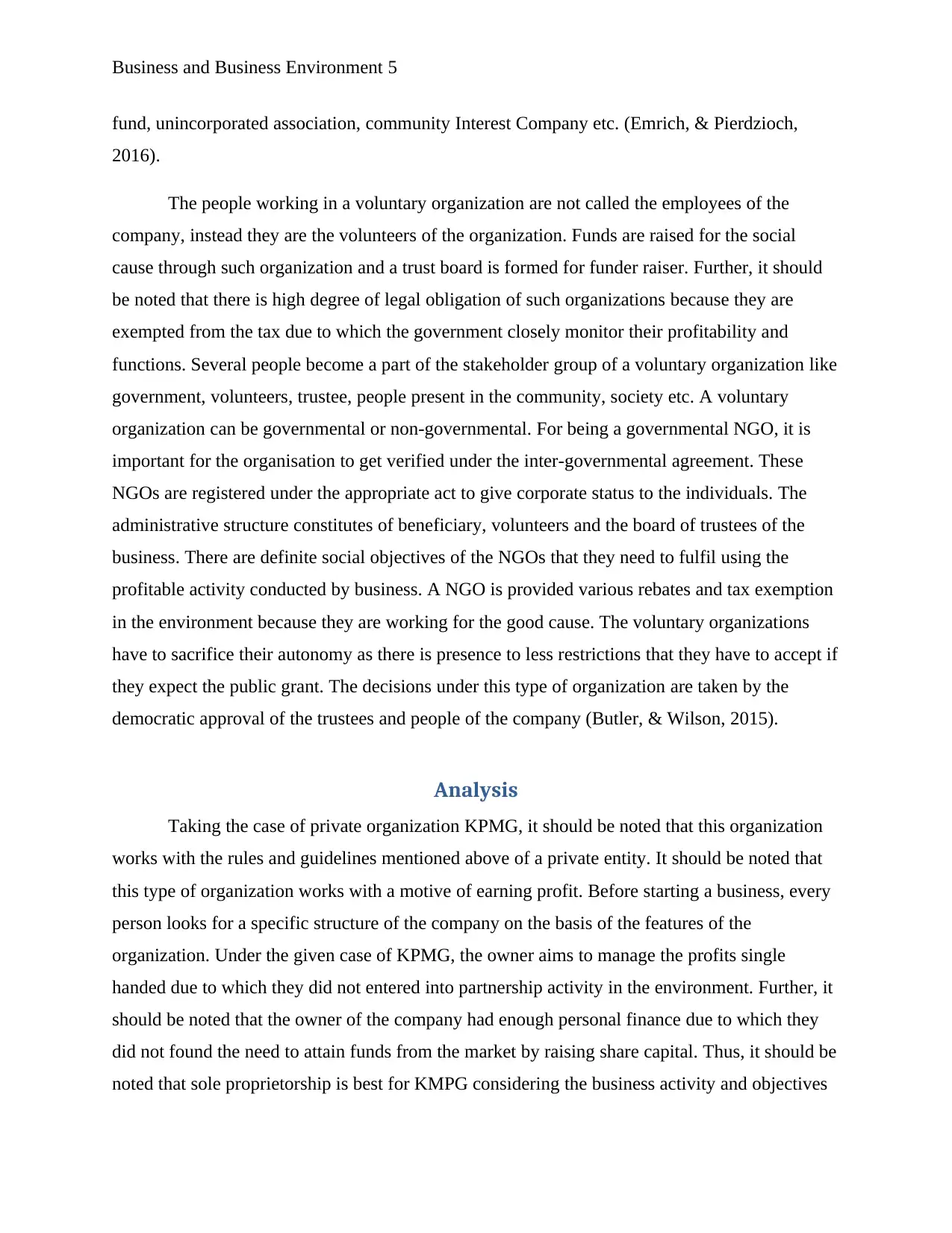
Business and Business Environment 5
fund, unincorporated association, community Interest Company etc. (Emrich, & Pierdzioch,
2016).
The people working in a voluntary organization are not called the employees of the
company, instead they are the volunteers of the organization. Funds are raised for the social
cause through such organization and a trust board is formed for funder raiser. Further, it should
be noted that there is high degree of legal obligation of such organizations because they are
exempted from the tax due to which the government closely monitor their profitability and
functions. Several people become a part of the stakeholder group of a voluntary organization like
government, volunteers, trustee, people present in the community, society etc. A voluntary
organization can be governmental or non-governmental. For being a governmental NGO, it is
important for the organisation to get verified under the inter-governmental agreement. These
NGOs are registered under the appropriate act to give corporate status to the individuals. The
administrative structure constitutes of beneficiary, volunteers and the board of trustees of the
business. There are definite social objectives of the NGOs that they need to fulfil using the
profitable activity conducted by business. A NGO is provided various rebates and tax exemption
in the environment because they are working for the good cause. The voluntary organizations
have to sacrifice their autonomy as there is presence to less restrictions that they have to accept if
they expect the public grant. The decisions under this type of organization are taken by the
democratic approval of the trustees and people of the company (Butler, & Wilson, 2015).
Analysis
Taking the case of private organization KPMG, it should be noted that this organization
works with the rules and guidelines mentioned above of a private entity. It should be noted that
this type of organization works with a motive of earning profit. Before starting a business, every
person looks for a specific structure of the company on the basis of the features of the
organization. Under the given case of KPMG, the owner aims to manage the profits single
handed due to which they did not entered into partnership activity in the environment. Further, it
should be noted that the owner of the company had enough personal finance due to which they
did not found the need to attain funds from the market by raising share capital. Thus, it should be
noted that sole proprietorship is best for KMPG considering the business activity and objectives
fund, unincorporated association, community Interest Company etc. (Emrich, & Pierdzioch,
2016).
The people working in a voluntary organization are not called the employees of the
company, instead they are the volunteers of the organization. Funds are raised for the social
cause through such organization and a trust board is formed for funder raiser. Further, it should
be noted that there is high degree of legal obligation of such organizations because they are
exempted from the tax due to which the government closely monitor their profitability and
functions. Several people become a part of the stakeholder group of a voluntary organization like
government, volunteers, trustee, people present in the community, society etc. A voluntary
organization can be governmental or non-governmental. For being a governmental NGO, it is
important for the organisation to get verified under the inter-governmental agreement. These
NGOs are registered under the appropriate act to give corporate status to the individuals. The
administrative structure constitutes of beneficiary, volunteers and the board of trustees of the
business. There are definite social objectives of the NGOs that they need to fulfil using the
profitable activity conducted by business. A NGO is provided various rebates and tax exemption
in the environment because they are working for the good cause. The voluntary organizations
have to sacrifice their autonomy as there is presence to less restrictions that they have to accept if
they expect the public grant. The decisions under this type of organization are taken by the
democratic approval of the trustees and people of the company (Butler, & Wilson, 2015).
Analysis
Taking the case of private organization KPMG, it should be noted that this organization
works with the rules and guidelines mentioned above of a private entity. It should be noted that
this type of organization works with a motive of earning profit. Before starting a business, every
person looks for a specific structure of the company on the basis of the features of the
organization. Under the given case of KPMG, the owner aims to manage the profits single
handed due to which they did not entered into partnership activity in the environment. Further, it
should be noted that the owner of the company had enough personal finance due to which they
did not found the need to attain funds from the market by raising share capital. Thus, it should be
noted that sole proprietorship is best for KMPG considering the business activity and objectives
⊘ This is a preview!⊘
Do you want full access?
Subscribe today to unlock all pages.

Trusted by 1+ million students worldwide
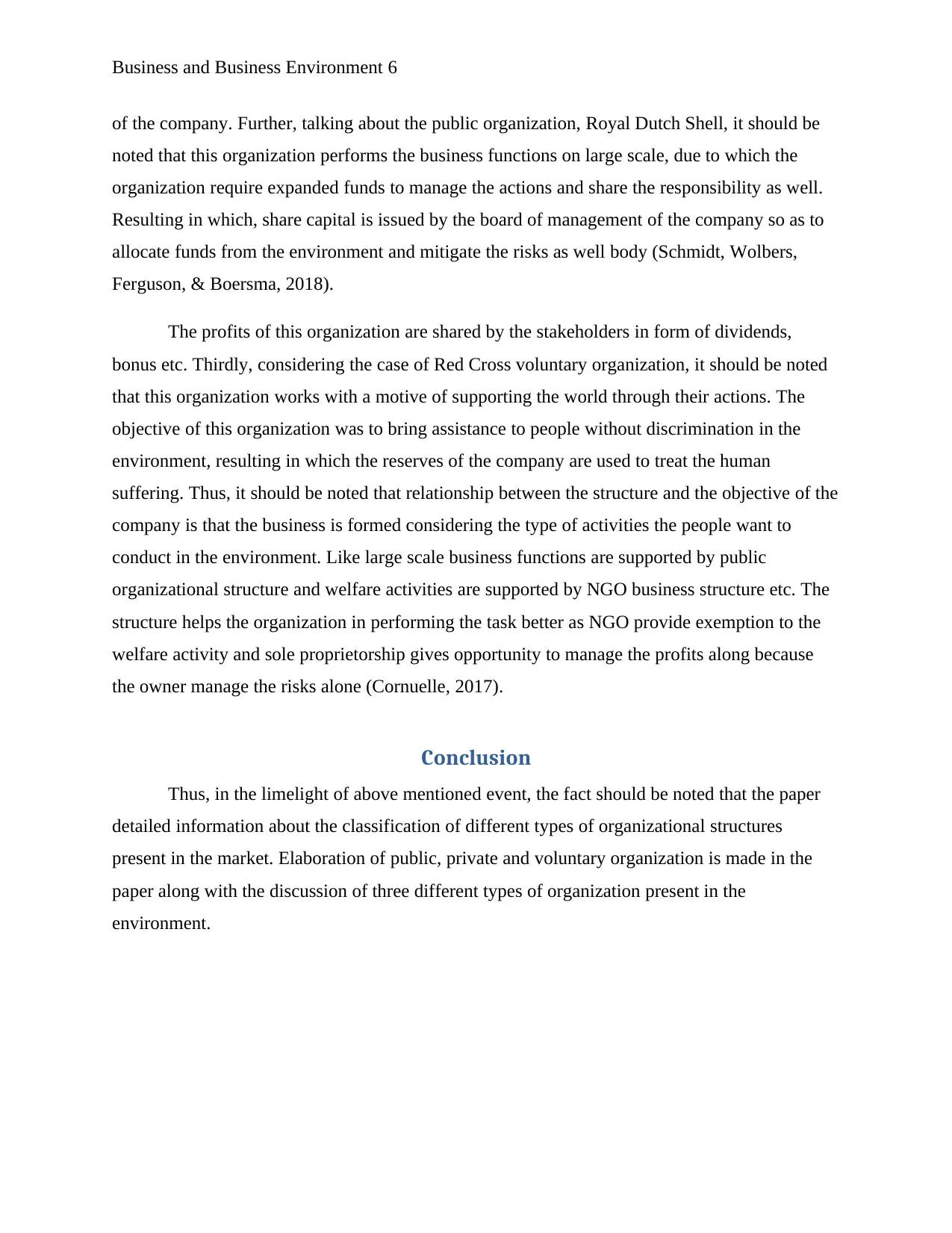
Business and Business Environment 6
of the company. Further, talking about the public organization, Royal Dutch Shell, it should be
noted that this organization performs the business functions on large scale, due to which the
organization require expanded funds to manage the actions and share the responsibility as well.
Resulting in which, share capital is issued by the board of management of the company so as to
allocate funds from the environment and mitigate the risks as well body (Schmidt, Wolbers,
Ferguson, & Boersma, 2018).
The profits of this organization are shared by the stakeholders in form of dividends,
bonus etc. Thirdly, considering the case of Red Cross voluntary organization, it should be noted
that this organization works with a motive of supporting the world through their actions. The
objective of this organization was to bring assistance to people without discrimination in the
environment, resulting in which the reserves of the company are used to treat the human
suffering. Thus, it should be noted that relationship between the structure and the objective of the
company is that the business is formed considering the type of activities the people want to
conduct in the environment. Like large scale business functions are supported by public
organizational structure and welfare activities are supported by NGO business structure etc. The
structure helps the organization in performing the task better as NGO provide exemption to the
welfare activity and sole proprietorship gives opportunity to manage the profits along because
the owner manage the risks alone (Cornuelle, 2017).
Conclusion
Thus, in the limelight of above mentioned event, the fact should be noted that the paper
detailed information about the classification of different types of organizational structures
present in the market. Elaboration of public, private and voluntary organization is made in the
paper along with the discussion of three different types of organization present in the
environment.
of the company. Further, talking about the public organization, Royal Dutch Shell, it should be
noted that this organization performs the business functions on large scale, due to which the
organization require expanded funds to manage the actions and share the responsibility as well.
Resulting in which, share capital is issued by the board of management of the company so as to
allocate funds from the environment and mitigate the risks as well body (Schmidt, Wolbers,
Ferguson, & Boersma, 2018).
The profits of this organization are shared by the stakeholders in form of dividends,
bonus etc. Thirdly, considering the case of Red Cross voluntary organization, it should be noted
that this organization works with a motive of supporting the world through their actions. The
objective of this organization was to bring assistance to people without discrimination in the
environment, resulting in which the reserves of the company are used to treat the human
suffering. Thus, it should be noted that relationship between the structure and the objective of the
company is that the business is formed considering the type of activities the people want to
conduct in the environment. Like large scale business functions are supported by public
organizational structure and welfare activities are supported by NGO business structure etc. The
structure helps the organization in performing the task better as NGO provide exemption to the
welfare activity and sole proprietorship gives opportunity to manage the profits along because
the owner manage the risks alone (Cornuelle, 2017).
Conclusion
Thus, in the limelight of above mentioned event, the fact should be noted that the paper
detailed information about the classification of different types of organizational structures
present in the market. Elaboration of public, private and voluntary organization is made in the
paper along with the discussion of three different types of organization present in the
environment.
Paraphrase This Document
Need a fresh take? Get an instant paraphrase of this document with our AI Paraphraser
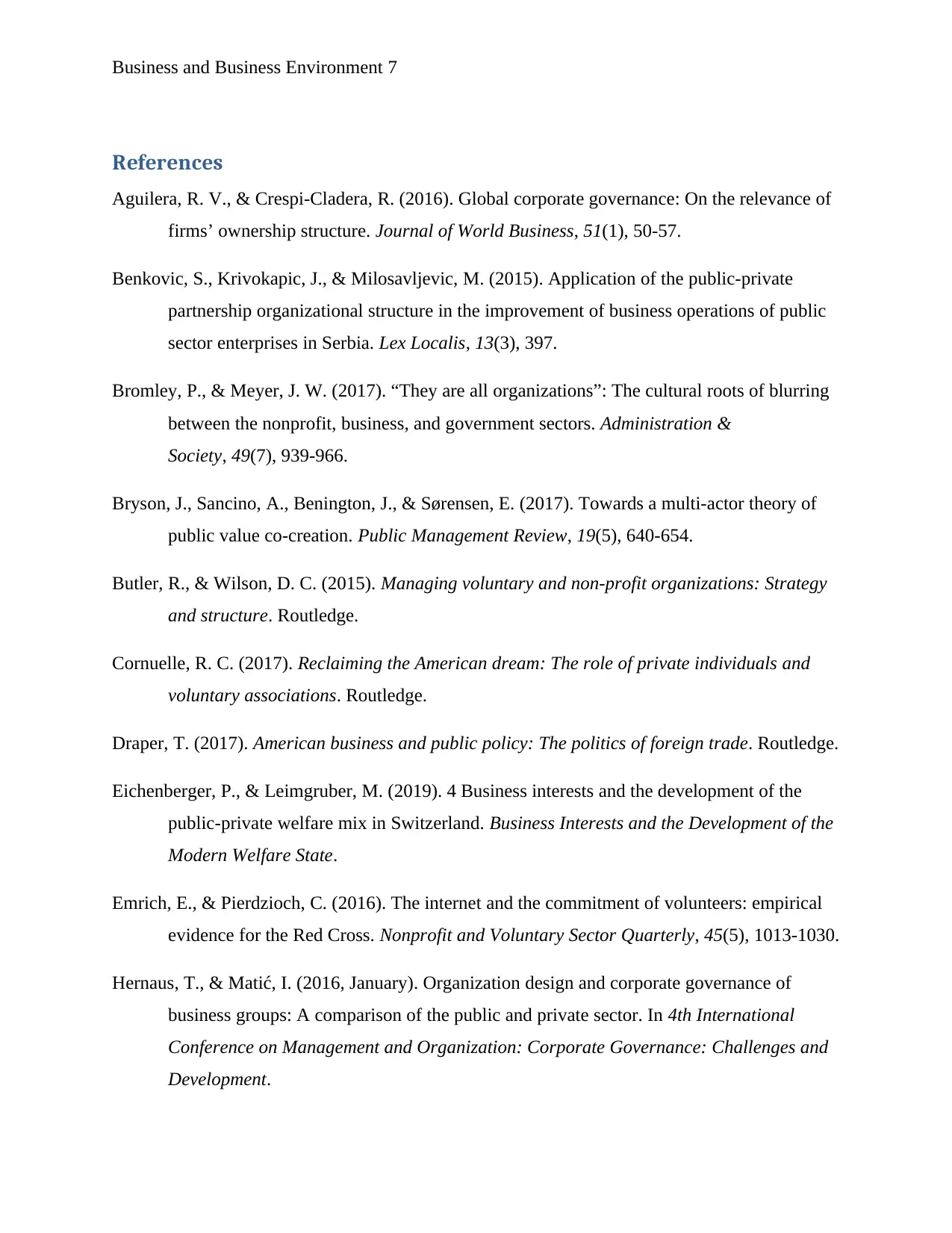
Business and Business Environment 7
References
Aguilera, R. V., & Crespi-Cladera, R. (2016). Global corporate governance: On the relevance of
firms’ ownership structure. Journal of World Business, 51(1), 50-57.
Benkovic, S., Krivokapic, J., & Milosavljevic, M. (2015). Application of the public-private
partnership organizational structure in the improvement of business operations of public
sector enterprises in Serbia. Lex Localis, 13(3), 397.
Bromley, P., & Meyer, J. W. (2017). “They are all organizations”: The cultural roots of blurring
between the nonprofit, business, and government sectors. Administration &
Society, 49(7), 939-966.
Bryson, J., Sancino, A., Benington, J., & Sørensen, E. (2017). Towards a multi-actor theory of
public value co-creation. Public Management Review, 19(5), 640-654.
Butler, R., & Wilson, D. C. (2015). Managing voluntary and non-profit organizations: Strategy
and structure. Routledge.
Cornuelle, R. C. (2017). Reclaiming the American dream: The role of private individuals and
voluntary associations. Routledge.
Draper, T. (2017). American business and public policy: The politics of foreign trade. Routledge.
Eichenberger, P., & Leimgruber, M. (2019). 4 Business interests and the development of the
public-private welfare mix in Switzerland. Business Interests and the Development of the
Modern Welfare State.
Emrich, E., & Pierdzioch, C. (2016). The internet and the commitment of volunteers: empirical
evidence for the Red Cross. Nonprofit and Voluntary Sector Quarterly, 45(5), 1013-1030.
Hernaus, T., & Matić, I. (2016, January). Organization design and corporate governance of
business groups: A comparison of the public and private sector. In 4th International
Conference on Management and Organization: Corporate Governance: Challenges and
Development.
References
Aguilera, R. V., & Crespi-Cladera, R. (2016). Global corporate governance: On the relevance of
firms’ ownership structure. Journal of World Business, 51(1), 50-57.
Benkovic, S., Krivokapic, J., & Milosavljevic, M. (2015). Application of the public-private
partnership organizational structure in the improvement of business operations of public
sector enterprises in Serbia. Lex Localis, 13(3), 397.
Bromley, P., & Meyer, J. W. (2017). “They are all organizations”: The cultural roots of blurring
between the nonprofit, business, and government sectors. Administration &
Society, 49(7), 939-966.
Bryson, J., Sancino, A., Benington, J., & Sørensen, E. (2017). Towards a multi-actor theory of
public value co-creation. Public Management Review, 19(5), 640-654.
Butler, R., & Wilson, D. C. (2015). Managing voluntary and non-profit organizations: Strategy
and structure. Routledge.
Cornuelle, R. C. (2017). Reclaiming the American dream: The role of private individuals and
voluntary associations. Routledge.
Draper, T. (2017). American business and public policy: The politics of foreign trade. Routledge.
Eichenberger, P., & Leimgruber, M. (2019). 4 Business interests and the development of the
public-private welfare mix in Switzerland. Business Interests and the Development of the
Modern Welfare State.
Emrich, E., & Pierdzioch, C. (2016). The internet and the commitment of volunteers: empirical
evidence for the Red Cross. Nonprofit and Voluntary Sector Quarterly, 45(5), 1013-1030.
Hernaus, T., & Matić, I. (2016, January). Organization design and corporate governance of
business groups: A comparison of the public and private sector. In 4th International
Conference on Management and Organization: Corporate Governance: Challenges and
Development.
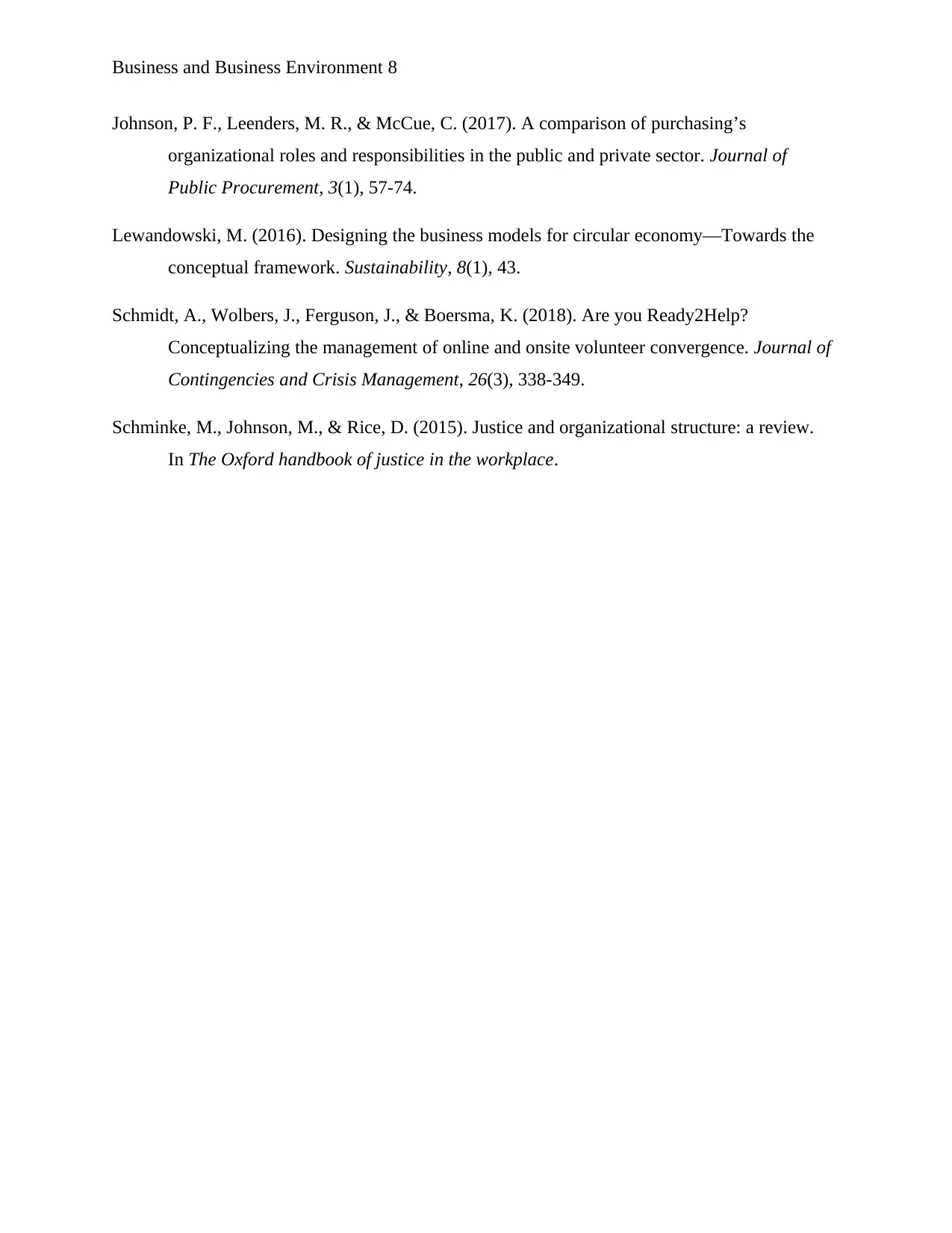
Business and Business Environment 8
Johnson, P. F., Leenders, M. R., & McCue, C. (2017). A comparison of purchasing’s
organizational roles and responsibilities in the public and private sector. Journal of
Public Procurement, 3(1), 57-74.
Lewandowski, M. (2016). Designing the business models for circular economy—Towards the
conceptual framework. Sustainability, 8(1), 43.
Schmidt, A., Wolbers, J., Ferguson, J., & Boersma, K. (2018). Are you Ready2Help?
Conceptualizing the management of online and onsite volunteer convergence. Journal of
Contingencies and Crisis Management, 26(3), 338-349.
Schminke, M., Johnson, M., & Rice, D. (2015). Justice and organizational structure: a review.
In The Oxford handbook of justice in the workplace.
Johnson, P. F., Leenders, M. R., & McCue, C. (2017). A comparison of purchasing’s
organizational roles and responsibilities in the public and private sector. Journal of
Public Procurement, 3(1), 57-74.
Lewandowski, M. (2016). Designing the business models for circular economy—Towards the
conceptual framework. Sustainability, 8(1), 43.
Schmidt, A., Wolbers, J., Ferguson, J., & Boersma, K. (2018). Are you Ready2Help?
Conceptualizing the management of online and onsite volunteer convergence. Journal of
Contingencies and Crisis Management, 26(3), 338-349.
Schminke, M., Johnson, M., & Rice, D. (2015). Justice and organizational structure: a review.
In The Oxford handbook of justice in the workplace.
⊘ This is a preview!⊘
Do you want full access?
Subscribe today to unlock all pages.

Trusted by 1+ million students worldwide
1 out of 9
Related Documents
Your All-in-One AI-Powered Toolkit for Academic Success.
+13062052269
info@desklib.com
Available 24*7 on WhatsApp / Email
![[object Object]](/_next/static/media/star-bottom.7253800d.svg)
Unlock your academic potential
Copyright © 2020–2025 A2Z Services. All Rights Reserved. Developed and managed by ZUCOL.





